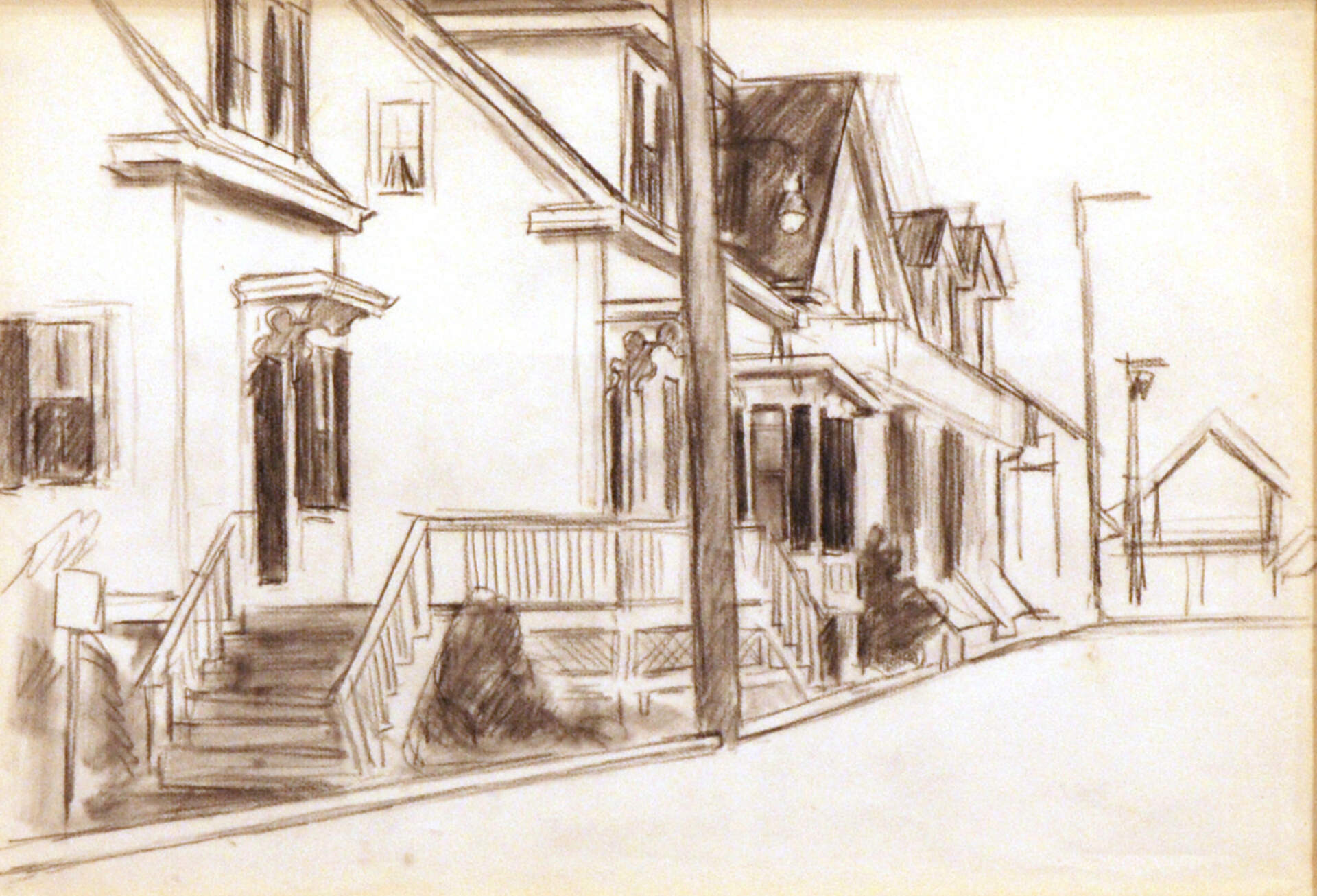Edward Hopper (1882-1967)Provincetown Houses-Day
circa 1926-30
Conté crayon on paper
17 1/2 x 22 7/8 inches (Frame: 22 x 27 1/2 inches)
Burchfield Penney Art Center, Gift of Murray and Wendy Warner in memory of Robert N. Blair, 2006
The following inscription about this drawing on the back of a black and white photograph (by Walter Rosenblum, #15105) is hand-written, signed “John Clancy, Director, Frank Rehn Gallery” and dated “Nov. 28th 1972”: “The drawing ‘Provincetown Houses–Day’ in conté crayon, size 11 9/16 x 17 inches, is in my opinion by Edward Hopper. The work of Edward Hopper has been handled by this gallery since 1924.”
Edward Hopper and Charles Burchfield were both represented by the Frank K. M. Rehn Gallery in New York City. They became lifelong friends and each wrote about the other’s work, which many people have compared for similarities in style and subject. Hopper’s article, “Charles Burchfield: American,” was published in The Arts magazine in July 1928, a year before Burchfield joined the Rehn Gallery. Burchfield wrote two essays: “Edward Hopper: Classicist” for The Museum of Modern Art’s 1933 retrospective exhibition and “Hopper: Career of Silent Poetry” for the March 1950 issue of ARTnews. Although they were colleagues, they also competed with one another, acknowledging privately, more often than publicly, that each thought he was the better artist. Art historians have written that “Hopper once strenuously objected to a writer’s suggestion that Burchfield had influenced him, and Burchfield took offense to the remark by American artist Guy Pène Du Bois that ‘Burchfield is only Hopper on a rainy day.’” Nevertheless, Hopper and Burchfield are still considered accomplished peers today.
This conté crayon drawing of a row of two-story houses with tall pitched roofs situated in a receding street view illustrates a facility with the medium and grasp of architectural detail and perspective that both artists employed with great success. Details in this drawing relate to several Hopper paintings. The lacy shape of the corbels supporting a small entry roof on one of the houses appears similarly in the following oil and watercolor paintings:
Gloucester Street, 1926, oil on canvas, 71.1 x 91.4 cm (28 x 56 in.),
Private Collection (ill. 83, Mecklenburg, p. 78)
Adam’s House, 1928, watercolor, 40.6 x 63.5 cm (16 x 25 in.),
The Roland P. Murdock Collection, Wichita Art Museum, Wichita, Kansas (ill. 84, Mecklenburg, p. 79)
Methodist Church Tower, 1930, watercolor, 63.5 x 50.2 cm (25 x 19 ¾ in.),
Wadsworth Atheneum, Hartford, The Ella Gallup Sumner and Mary Catlin Sumner Collection Fund
(ill. 101, Mecklenburg, p. 99)
House at Provincetown, 1930, watercolor on paper, 20 1/4 x 25 1/2 inches, Purchase, U.S. State Department Collection, War Assets Administration, 1948
[See Edward Hopper: The Watercolors by Virginia M. Mecklenburg, Washington, DC: National Museum of American Art, Smithsonian Institution, 1999.]
I believe it is most likely related to House at Provincetown (1930) and Methodist Church Tower (1930) as part of the row of houses on Main Street in Provincetown, seen from the opposite direction from the church in the painting. The other two works, Gloucester Street (1926) and Adam’s House (1928), were both painted in Gloucester. The vernacular American architectural style is typical of a number of towns in Cape Cod.
Edward Hopper said, “Maybe I am slightly inhuman ... All I ever wanted to do was to paint sunlight on the side of a house.”
— Nancy Weekly, Burchfield Scholar, Head of Collections and the Charles Cary Rumsey Curator
